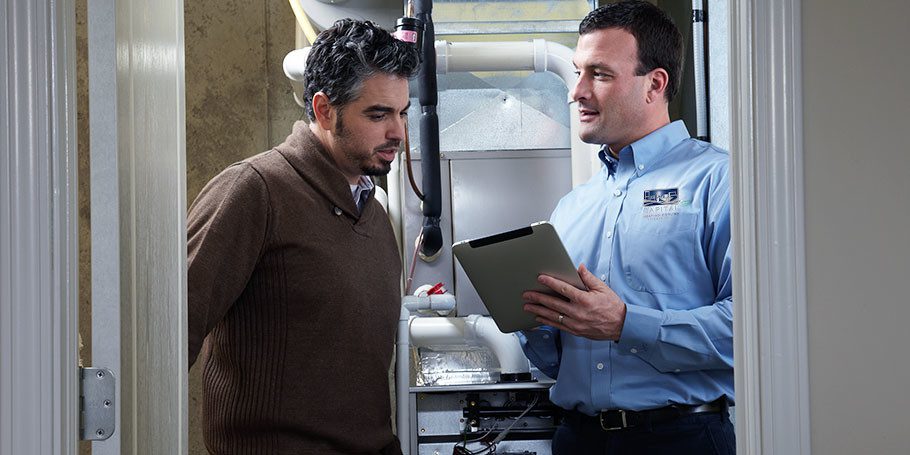Standard vs. High-Efficiency Gas Furnace Replacement Cost
A standard-efficiency gas furnace costs $2,150-$5,900, according to the 2020 national averages, with most homeowners spending around $4,000. This may or may not include additional costs including permits, warranty, or necessary electrical work.
A high-efficiency gas furnace on the other hand costs $6,000-$8,000. Despite the higher price tag, homeowners who live in SE Wisconsin during the winters, see greater benefits of upgrading to a high efficiency furnace.
Home Advisor, used by over 30 million homeowners says the average cost to replace a gas furnace is $3,800 – $10,000. With the Midwest trending on the higher end because of our harsh winters.
Furnace Replacement Cost Factors
Why does a 7 series BMW cost more than a Hyundai Accent? It’s faster, more durable, more comfortable, has better safety ratings…and the list goes on. Furnaces aren’t much different; the cost of a new furnace really comes down to 5 things:
Installation Quality
The cost to replace a furnace includes more than just the furnace itself, and the inclusions will be reflected in the cost.
A high-quality furnace installation includes
- Permit fees
- Removal of old equipment
- NATE certified technicians
- Warranty coverage
- The furnace is on blocks or pads
- Booties & floor coverings
Ask what additional costs are involved if these things are not discussed and/or written in your furnace replacement proposal.
Equipment Quality
Like any mechanical system, a furnace is the sum total of its parts. Furnace parts are made in good, better, and best qualities, to produce furnaces in those three categories. Noticeable quality differences can be found in furnace blower motors, draft inducer motors, gas valve assemblies, and electrical components. Similarly, better furnaces have more insulation and higher-quality cabinets, two features designed to reduce noise and heat loss.
The lifespan of the furnace is also affected by its quality. Lower cost furnaces are known to have a shorter lifespan and may require more frequent replacement.
- Cheap furnaces: 12-16 years with multiple repairs
- Midrange furnaces: 15-20 years with a few repairs
- Best furnaces: 17-25 years with a few repairs
Efficiency Rating
A high-efficiency furnace costs more initially but the investment is quickly recouped in savings on annual heating costs, fewer repairs & a longer lifespan.
A standard-efficiency furnace is cheaper upfront but costs more to operate. Many landlords buy standard-efficiency furnaces because they’re cheaper and typically they’re not responsible for paying the monthly heat bill.
Brand
Did you know there are only a few companies that own and/or manufacture all the different brands of furnaces? Take Amana and Goodman furnaces for example; both owned by Daikin Global and between the two brands there are 17 models, however, nearly all the models are identical in everything but the cabinet around them and the name tag on them. In fact, in many situations, the furnaces don’t get a brand badge until they are being loaded up on a truck.
So, why do furnace brands have different prices? In the case of Goodman vs. Amana, Goodman has lower prices; Amana has better warranties on some furnaces. The better warranties on some of the Amana models mean that they cost more – up to $300 more than the Goodman version. From a brand perspective, that’s what it comes down to.
How to choose a furnace replacement company is the bigger question.
Features
Similarly, to our BMW vs. Hyundai analogy, a furnace tends to cost more when it has more features. Things like warranties, blowers, air filtration, heat output, dual heat exchangers, zoning, and the ignition system come into play.
- Warrantees Basic, usually low efficiency, furnaces often have a shorter warranty than their premium counterparts.
- Variable speed blowers deliver air slower, while often making less noise when less heat is needed. That produces fewer drafts and uncomfortable swings in temperature.
- Variable heat output can increase efficiency and comfort by automatically changing the amount of heat the furnace delivers, usually between two levels. The furnace can thus deliver heat more continuously than could one with a fixed heat output
- Air Filtration upgrades such as a High Performance Air Filter are a common feature for those with asthma or another chronic lung disease.
- Dual Heat Exchanger draws more heat from the air
- Ignition System can increase efficiency and is usually reflected in a furnace’s higher AFUE rating
- Zoned heating uses a number of thermostats, a sophisticated central controller, and a series of dampers that control airflow to deliver different amounts of heating or cooling to different parts of the home.




